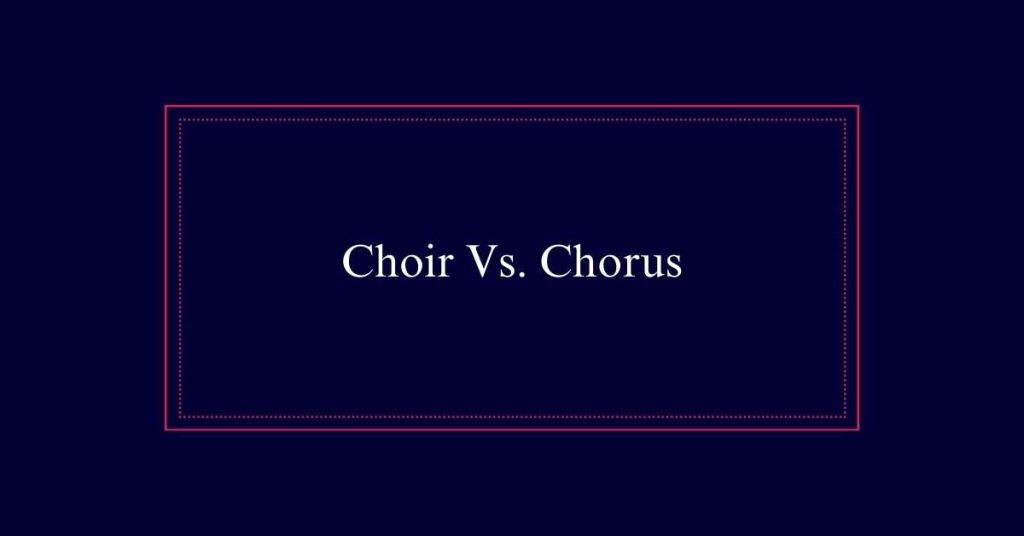Choir Vs. Chorus
A choir is an organized group of singers that typically performs vocal music in unison or harmony. They are often found in places like churches, schools, and community groups, and are divided into vocal ranges such as soprano, alto, tenor, and bass. A chorus, on the other hand, is usually a larger group of singers that can participate in various musical settings like operas and musical theater. The term “chorus” also refers to the repeating part of a song.
Definition of Choir
A choir is an organized group of singers who perform together. This group typically practices and performs vocal music in unison or harmony. Choirs can vary in size, from small ensembles to large groups. They are often found in places of worship, schools, and community organizations. Members of a choir may be divided into sections based on vocal range, such as soprano, alto, tenor, and bass.
The term ‘choir’ can also refer to the specific area in a building where these singers stand during a performance. Additionally, ‘choir’ can describe a group of similar instruments or even a division of angels. The primary focus remains on the collective effort of vocal performance.
Definition of Chorus
Frequently, the term ‘chorus’ denotes a large group of singers who perform together. This can include performers in various musical settings such as operas, where they sing the choral parts. In addition to singing groups, ‘chorus’ may also refer to specific performers in Athenian drama or musical comedy, often combining singing and dancing.
Additionally, ‘chorus’ describes a part of a song that repeats at intervals, known as the refrain. This portion is usually memorable and catchy.
Beyond music, ‘chorus’ can also mean anything done simultaneously by a group, such as chanting or speaking. Therefore, while primarily musical, the term ‘chorus’ has broader applications encompassing both performance and repetition.
Historical Contexts
Throughout history, both the choir and chorus have played significant roles in various cultural and religious ceremonies.
In ancient Greece, the chorus was integral to theatrical performances, combining music, dance, and poetry to narrate stories and express communal emotions.
Meanwhile, choirs have been essential in religious contexts, particularly within Christian traditions, where organized groups of singers perform hymns and liturgical music.
Medieval and Renaissance churches often featured choirs to enhance the spiritual atmosphere of services.
Over time, both choirs and choruses expanded into secular domains, contributing to operas, concerts, and other public events.

Their historical evolution underscores their importance in shaping communal and artistic expressions across different societies and eras.
Types of Choirs
There are several distinct types of choirs, each serving different musical and cultural functions. Some choirs are categorized by the voices they include, such as mixed choirs, male choirs, and female choirs. Others are defined by their membership, like children’s choirs or community choirs. Each type brings unique qualities and repertoire to performances.
| Choir Type | Description |
|---|---|
| Mixed Choir | Includes soprano, alto, tenor, bass |
| Male Choir | Consists of tenor, baritone, and bass |
| Female Choir | Made up of soprano and alto voices |
These distinctions help in selecting appropriate music and ensuring balanced performances. Choirs contribute richly to cultural and musical traditions through their specialized compositions and performances.
Types of Choruses
In musical contexts, choruses can vary widely in their composition and function. A traditional chorus often comprises a large group of singers who perform together in unison or harmony. In opera, the chorus consists of singers who provide choral parts, enhancing the narrative.
Musical theater choruses include singers and dancers who contribute to the storytelling through song and movement. Pop and rock songs feature a chorus as the repeating section that anchors the composition. Additionally, a chorus can refer to any collective vocal or instrumental expression performed simultaneously.
Differences in Usage
Understanding the differences in usage between ‘choir’ and ‘chorus’ helps clarify their distinct roles in various musical and non-musical contexts.
A ‘choir’ typically refers to an organized group of singers, often found in religious or formal settings. It can also denote a group of similar instruments or a section in a building where singers stand.
Conversely, a ‘chorus’ can refer to a large group of singers but may also include dancers or actors, especially in theatrical performances. Additionally, ‘chorus’ denotes the part of a song that repeats at intervals.
While both terms can describe groups performing together, ‘choir’ is more specific to singing, whereas ‘chorus’ has broader applications, including spoken and simultaneous actions.
Similarities Explained
Both ‘choir’ and ‘chorus’ describe groups of people performing together, primarily through singing. They are often used interchangeably when referring to an ensemble of singers. Both terms can denote a collective effort in musical performances, emphasizing harmony and unity.
While traditionally a choir is more associated with formal and organized settings, such as churches or schools, a chorus can also be seen in theatrical productions and operas. Despite their different connotations, both groups aim to blend voices to create a cohesive sound.
Additionally, both terms can extend beyond music to describe any group acting in unison, reflecting their shared emphasis on collective participation and synchronized performance. This underscores their fundamental similarity in nature and function.
Choirs in Religion
Many religious traditions incorporate choirs to enhance worship and spiritual experiences.
In Christianity, church choirs often perform hymns and sacred music during services, creating an atmosphere of reverence and community. These choirs can range from small groups to large ensembles, each contributing to the liturgy.
In Judaism, synagogue choirs may accompany cantors, enriching prayers and religious ceremonies.
Similarly, Hindu temples utilize bhajan groups to lead devotional songs, fostering a sense of devotion and unity among worshippers.
Islamic traditions, though less focused on choral arrangements, still feature group recitations of the Quran, blending voices in a spiritually uplifting manner.
Choruses in Performance
While choirs play an essential role in religious settings, choruses excel in the domain of theatrical and musical performances. In these contexts, choruses bring a dynamic and versatile element to the stage. They are often integral to the storytelling and emotional impact of a production.
Choruses in performance are characterized by their ability to blend music, dance, and acting. This creates a multifaceted experience for the audience. Their role is vital in bringing energy and cohesion to productions, making them indispensable in the performing arts.
- Musicals: Choruses perform elaborate song and dance numbers, enhancing the visual and auditory experience.
- Operas: Choruses provide powerful vocal support, enriching the dramatic narrative.
- Theater: Choruses offer commentary and move the plot forward through collective performance.
Common Misconceptions
A common misconception is that the terms ‘choir’ and ‘chorus’ are fully interchangeable. While both refer to groups of singers, their uses differ.
A ‘choir’ specifically denotes an organized group of singers, often associated with religious or formal settings.
A ‘chorus,’ on the other hand, can include not only singers but also dancers and actors, especially in theatrical contexts. Additionally, ‘chorus’ refers to the repeated section of a song, a usage not applicable to ‘choir.’
These distinctions are important for clarity. For example, in an opera, the ‘chorus’ performs choral parts, but a ‘choir’ typically does not involve dance or acting. Understanding these differences helps prevent confusion in discussions about musical and performance groups.
Frequently Asked Questions
How Do You Join a Choir or Chorus?
To join a choir or chorus, research local groups, inquire about auditions or open rehearsals, and demonstrate your vocal ability. Commitment to practice and willingness to collaborate are essential for integration into the ensemble.
What Are the Benefits of Singing in a Choir or Chorus?
Singing in a choir or chorus offers numerous benefits. It enhances vocal skills, fosters teamwork, and builds a sense of community. Additionally, it reduces stress, improves mental health, and provides opportunities to perform and connect with others.
Are There Age Restrictions for Joining Choirs or Choruses?
Age restrictions for joining choirs or choruses vary by group. Some are open to all ages, while others are tailored to specific age ranges, such as children’s, youth, or adult choirs. Always check individual group requirements.
How Do Rehearsals for Choirs and Choruses Typically Differ?
Rehearsals for choirs typically focus on vocal techniques, harmony, and blending voices. Chorus rehearsals may include additional elements like choreography and acting, especially in musical theater or opera, due to the diversified performance requirements.
Can Choirs and Choruses Perform the Same Musical Pieces?
Yes, choirs and choruses can perform the same musical pieces. Both groups consist of singers, though choruses may include dancers or actors. The distinction lies in performance context rather than the repertoire itself.






